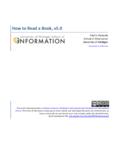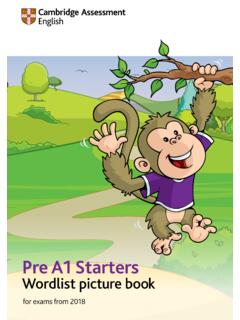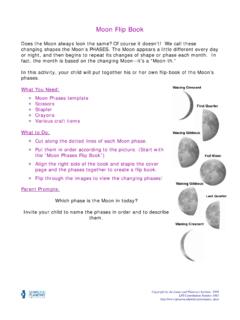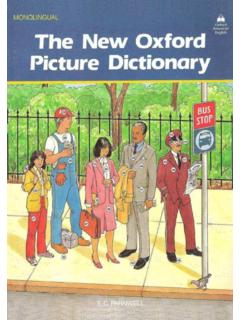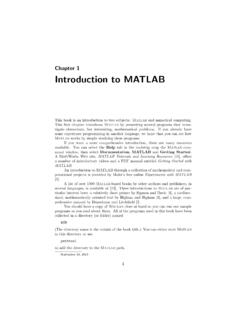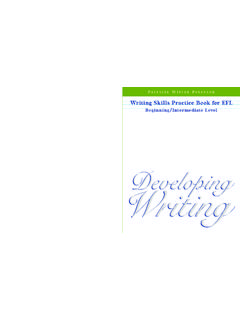Transcription of How to Read a Book r6 - University of Michigan
1 How to read a book , Paul N. Edwards School of Information University of Michigan This work is licensed under a Creative Commons Attribution-NonCommercial-ShareAlike International License. The terms of this licence allow you to remix, tweak, and build upon this work non-commercially, as long as you credit me and license your new creations under the identical terms. Quasi-permanent URL: Paul N. Edwards How to read a book 1 How can you learn the most from a book or any other piece of writing when you're reading for information, rather than for pleasure? It s satisfying to start at the beginning and read straight through to the end. Some books, such as novels, have to be read this way, since a basic principle of fiction is to hold the reader in suspense.
2 Your whole purpose in reading fiction is to follow the writer s lead, allowing him or her to spin a story bit by bit. But many of the books, articles, and other documents you ll read during your undergraduate and graduate years, and possibly during the rest of your professional life, won t be novels. Instead, they ll be non-fiction: textbooks, manuals, journal articles, histories, academic studies, and so on. The purpose of reading things like this is to gain, and retain, information. Here, finding out what happens as quickly and easily as possible is your main goal. So unless you re stuck in prison with nothing else to do, NEVER read a non-fiction book or article from beginning to end. Instead, when you re reading for information, you should ALWAYS jump ahead, skip around, and use every available strategy to discover, then to understand, and finally to remember what the writer has to say.
3 This is how you ll get the most out of a book in the smallest amount of time. Using the methods described here, you should be able to read a 300-page book in six to eight hours. Of course, the more time you spend, the more you ll learn and the better you ll understand the book . But your time is limited. Here are some strategies to help you do this effectively. Most of these can be applied not only to books, but also to any other kind of non-fiction reading, from articles to websites. Table 1, on the next page, summarizes the techniques, and the following pages explain them in more detail. read the whole thing! In reading to learn, your goal should always be to get all the way through the assignment. It s much more important to have a general grasp of the arguments or hypotheses, evidence, and conclusions than to understand every detail.
4 In fact, no matter how carefully you read , you won t remember most of the details anyway. What you can do is remember and record the main points. And if you remember those, you know enough to find the material again if you ever do need to recall the details. Paul N. Edwards How to read a book 2 Table 1. Summary of reading strategies and techniques Strategies and techniques Rationale read the whole thing Major arguments and evidence matter more than details. Grasping the structure of the whole is more important than reading every word. Decide how much time you will spend Real-world time is limited. If you know exactly how long you can actually spend on reading, you can plan how much time to devote to each item.
5 Have a purpose and a strategy You'll enjoy reading more, and remember it better, if you know exactly why you're reading. read actively Never rely on the author's structures alone. Move around in the text, following your own goals. read it three times First time for overview and discovery. Second time for detail and understanding. Third time for note-taking in your own words. Focus on parts with high information content Tables of contents, pictures , charts, headings, and other elements contain more information than body text. Use PTML (personal text markup language) Mark up your reading with your own notes. This helps you learn and also helps you find important passages later. Know the author(s) and organizations Authors are people with backgrounds and biases.
6 They work in organizations that give them context and depth. Know the intellectual context Most academic writing is part of an ongoing intellectual conversation, with debates, key figures, and paradigmatic concepts. Use your unconscious mind Leave time between reading sessions for your mind to process the material. Rehearse, and use multiple modes Talking, visualizing, or writing about what you've read helps you remember it. Decide how much time you will spend If you know in advance that you have only six hours to read , it ll be easier to pace yourself. Remember, you re going to read the whole book (or the whole assignment). Paul N. Edwards How to read a book 3 In fact, the more directly and realistically you confront your limits, the more effective you will be at practically everything.
7 Setting time limits and keeping to them (while accomplishing your goals) is one of the most important life skills you can learn. So never start to read without planning when to stop. Have a purpose and a strategy Before you begin, figure out why you are reading this particular book , and how you are going to read it. If you don t have reasons and strategies of your own not just those of your teacher you won t learn as much. As soon as you start to read , begin trying to find out four things: Who is the author? What are the book s arguments? What is the evidence that supports these? What are the book s conclusions? Once you ve got a grip on these, start trying to determine: What are the weaknesses of these arguments, evidence, and conclusions?
8 What do you think about the arguments, evidence, and conclusions? How does (or how could) the author respond to these weaknesses, and to your own criticisms? Keep coming back to these questions as you read . By the time you finish, you should be able to answer them all. Three good ways to think about this are: a) Imagine that you re going to review the book for a magazine. b) Imagine that you re having a conversation, or a formal debate, with the author. c) Imagine an examination on the book . What would the questions be, and how would you answer them? read actively Don t wait for the author to hammer you over the head. Instead, from the very beginning, constantly generate hypotheses ( the main point of the book is ) and questions ( How does the author know ) about the book .
9 Making brief notes about these can help. As you read , try to confirm your hypotheses and answer your questions. Once you finish, review these. Know the author(s) and organizations Knowing who wrote a book helps you judge its quality and understand its full significance. Paul N. Edwards How to read a book 4 Authors are people. Like anyone else, their views are shaped by their educations, their jobs, their early lives, and the rest of their experiences. Also like anyone else, they have prejudices, blind spots, desperate moments, failings, and desires as well as insights, brilliance, objectivity, and successes. Notice all of it. Most authors belong to organizations: universities, corporations, governments, newspapers, magazines.
10 These organizations each have cultures, hierarchies of power, and social norms. Organizations shape both how a work is written and the content of what it says. For example, University professors are expected to write books and/or journal articles in order to get tenure. These pieces of writing must meet certain standards of quality, defined chiefly by other professors; for them, content usually matters more than good writing. Journalists, by contrast, are often driven by deadlines and the need to please large audiences. Because of this, their standards of quality are often directed more toward clear and engaging writing than toward unimpeachable content; their sources are usually oral rather than written. The more you know about the author and his/her organization and/or discipline, the better you will be able to evaluate what you read .
